Andrew Saxe
Revisiting the Role of Relearning in Semantic Dementia
Mar 05, 2025Abstract:Patients with semantic dementia (SD) present with remarkably consistent atrophy of neurons in the anterior temporal lobe and behavioural impairments, such as graded loss of category knowledge. While relearning of lost knowledge has been shown in acute brain injuries such as stroke, it has not been widely supported in chronic cognitive diseases such as SD. Previous research has shown that deep linear artificial neural networks exhibit stages of semantic learning akin to humans. Here, we use a deep linear network to test the hypothesis that relearning during disease progression rather than particular atrophy cause the specific behavioural patterns associated with SD. After training the network to generate the common semantic features of various hierarchically organised objects, neurons are successively deleted to mimic atrophy while retraining the model. The model with relearning and deleted neurons reproduced errors specific to SD, including prototyping errors and cross-category confusions. This suggests that relearning is necessary for artificial neural networks to reproduce the behavioural patterns associated with SD in the absence of \textit{output} non-linearities. Our results support a theory of SD progression that results from continuous relearning of lost information. Future research should revisit the role of relearning as a contributing factor to cognitive diseases.
Training Dynamics of In-Context Learning in Linear Attention
Jan 27, 2025Abstract:While attention-based models have demonstrated the remarkable ability of in-context learning, the theoretical understanding of how these models acquired this ability through gradient descent training is still preliminary. Towards answering this question, we study the gradient descent dynamics of multi-head linear self-attention trained for in-context linear regression. We examine two parametrizations of linear self-attention: one with the key and query weights merged as a single matrix (common in theoretical studies), and one with separate key and query matrices (closer to practical settings). For the merged parametrization, we show the training dynamics has two fixed points and the loss trajectory exhibits a single, abrupt drop. We derive an analytical time-course solution for a certain class of datasets and initialization. For the separate parametrization, we show the training dynamics has exponentially many fixed points and the loss exhibits saddle-to-saddle dynamics, which we reduce to scalar ordinary differential equations. During training, the model implements principal component regression in context with the number of principal components increasing over training time. Overall, we characterize how in-context learning abilities evolve during gradient descent training of linear attention, revealing dynamics of abrupt acquisition versus progressive improvements in models with different parametrizations.
Early learning of the optimal constant solution in neural networks and humans
Jun 25, 2024



Abstract:Deep neural networks learn increasingly complex functions over the course of training. Here, we show both empirically and theoretically that learning of the target function is preceded by an early phase in which networks learn the optimal constant solution (OCS) - that is, initial model responses mirror the distribution of target labels, while entirely ignoring information provided in the input. Using a hierarchical category learning task, we derive exact solutions for learning dynamics in deep linear networks trained with bias terms. Even when initialized to zero, this simple architectural feature induces substantial changes in early dynamics. We identify hallmarks of this early OCS phase and illustrate how these signatures are observed in deep linear networks and larger, more complex (and nonlinear) convolutional neural networks solving a hierarchical learning task based on MNIST and CIFAR10. We explain these observations by proving that deep linear networks necessarily learn the OCS during early learning. To further probe the generality of our results, we train human learners over the course of three days on the category learning task. We then identify qualitative signatures of this early OCS phase in terms of the dynamics of true negative (correct-rejection) rates. Surprisingly, we find the same early reliance on the OCS in the behaviour of human learners. Finally, we show that learning of the OCS can emerge even in the absence of bias terms and is equivalently driven by generic correlations in the input data. Overall, our work suggests the OCS as a universal learning principle in supervised, error-corrective learning, and the mechanistic reasons for its prevalence.
When Are Bias-Free ReLU Networks Like Linear Networks?
Jun 18, 2024Abstract:We investigate the expressivity and learning dynamics of bias-free ReLU networks. We firstly show that two-layer bias-free ReLU networks have limited expressivity: the only odd function two-layer bias-free ReLU networks can express is a linear one. We then show that, under symmetry conditions on the data, these networks have the same learning dynamics as linear networks. This allows us to give closed-form time-course solutions to certain two-layer bias-free ReLU networks, which has not been done for nonlinear networks outside the lazy learning regime. While deep bias-free ReLU networks are more expressive than their two-layer counterparts, they still share a number of similarities with deep linear networks. These similarities enable us to leverage insights from linear networks, leading to a novel understanding of bias-free ReLU networks. Overall, our results show that some properties established for bias-free ReLU networks arise due to equivalence to linear networks, and suggest that including bias or considering asymmetric data are avenues to engage with nonlinear behaviors.
Get rich quick: exact solutions reveal how unbalanced initializations promote rapid feature learning
Jun 10, 2024



Abstract:While the impressive performance of modern neural networks is often attributed to their capacity to efficiently extract task-relevant features from data, the mechanisms underlying this rich feature learning regime remain elusive, with much of our theoretical understanding stemming from the opposing lazy regime. In this work, we derive exact solutions to a minimal model that transitions between lazy and rich learning, precisely elucidating how unbalanced layer-specific initialization variances and learning rates determine the degree of feature learning. Our analysis reveals that they conspire to influence the learning regime through a set of conserved quantities that constrain and modify the geometry of learning trajectories in parameter and function space. We extend our analysis to more complex linear models with multiple neurons, outputs, and layers and to shallow nonlinear networks with piecewise linear activation functions. In linear networks, rapid feature learning only occurs with balanced initializations, where all layers learn at similar speeds. While in nonlinear networks, unbalanced initializations that promote faster learning in earlier layers can accelerate rich learning. Through a series of experiments, we provide evidence that this unbalanced rich regime drives feature learning in deep finite-width networks, promotes interpretability of early layers in CNNs, reduces the sample complexity of learning hierarchical data, and decreases the time to grokking in modular arithmetic. Our theory motivates further exploration of unbalanced initializations to enhance efficient feature learning.
Tilting the Odds at the Lottery: the Interplay of Overparameterisation and Curricula in Neural Networks
Jun 03, 2024
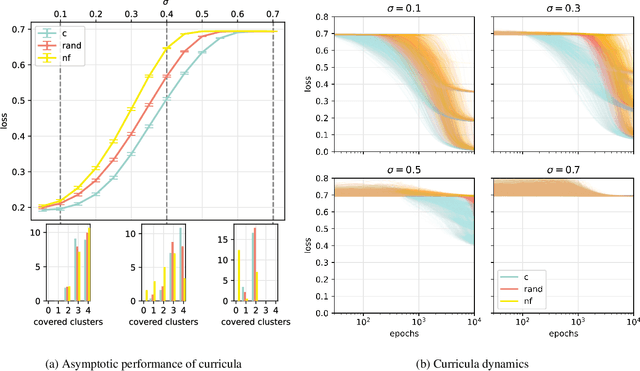
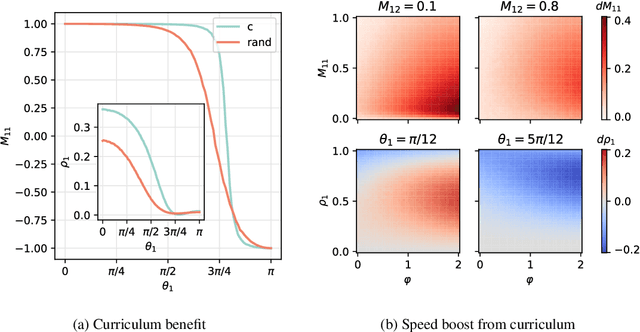
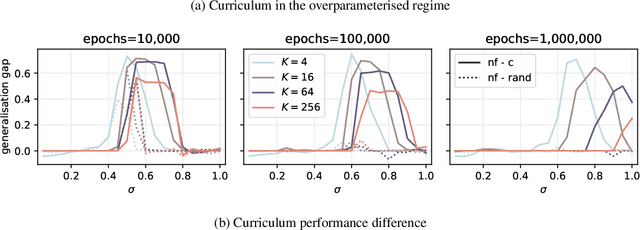
Abstract:A wide range of empirical and theoretical works have shown that overparameterisation can amplify the performance of neural networks. According to the lottery ticket hypothesis, overparameterised networks have an increased chance of containing a sub-network that is well-initialised to solve the task at hand. A more parsimonious approach, inspired by animal learning, consists in guiding the learner towards solving the task by curating the order of the examples, i.e. providing a curriculum. However, this learning strategy seems to be hardly beneficial in deep learning applications. In this work, we undertake an analytical study that connects curriculum learning and overparameterisation. In particular, we investigate their interplay in the online learning setting for a 2-layer network in the XOR-like Gaussian Mixture problem. Our results show that a high degree of overparameterisation -- while simplifying the problem -- can limit the benefit from curricula, providing a theoretical account of the ineffectiveness of curricula in deep learning.
A Theory of Unimodal Bias in Multimodal Learning
Dec 01, 2023Abstract:Using multiple input streams simultaneously in training multimodal neural networks is intuitively advantageous, but practically challenging. A key challenge is unimodal bias, where a network overly relies on one modality and ignores others during joint training. While unimodal bias is well-documented empirically, our theoretical understanding of how architecture and data statistics influence this bias remains incomplete. Here we develop a theory of unimodal bias with deep multimodal linear networks. We calculate the duration of the unimodal phase in learning as a function of the depth at which modalities are fused within the network, dataset statistics, and initialization. We find that the deeper the layer at which fusion occurs, the longer the unimodal phase. A long unimodal phase can lead to a generalization deficit and permanent unimodal bias in the overparametrized regime. In addition, our theory reveals the modality learned first is not necessarily the modality that contributes more to the output. Our results, derived for multimodal linear networks, extend to ReLU networks in certain settings. Taken together, this work illuminates pathologies of multimodal learning under joint training, showing that late and intermediate fusion architectures can give rise to long unimodal phases and permanent unimodal bias.
Continual task learning in natural and artificial agents
Oct 10, 2022


Abstract:How do humans and other animals learn new tasks? A wave of brain recording studies has investigated how neural representations change during task learning, with a focus on how tasks can be acquired and coded in ways that minimise mutual interference. We review recent work that has explored the geometry and dimensionality of neural task representations in neocortex, and computational models that have exploited these findings to understand how the brain may partition knowledge between tasks. We discuss how ideas from machine learning, including those that combine supervised and unsupervised learning, are helping neuroscientists understand how natural tasks are learned and coded in biological brains.
Know your audience: specializing grounded language models with the game of Dixit
Jun 16, 2022



Abstract:Effective communication requires adapting to the idiosyncratic common ground shared with each communicative partner. We study a particularly challenging instantiation of this problem: the popular game Dixit. We formulate a round of Dixit as a multi-agent image reference game where a (trained) speaker model is rewarded for describing a target image such that one (pretrained) listener model can correctly identify it from a pool of distractors, but another listener cannot. To adapt to this setting, the speaker must exploit differences in the common ground it shares with the different listeners. We show that finetuning an attention-based adapter between a CLIP vision encoder and a large language model in this contrastive, multi-agent setting gives rise to context-dependent natural language specialization from rewards only, without direct supervision. In a series of controlled experiments, we show that the speaker can adapt according to the idiosyncratic strengths and weaknesses of various pairs of different listeners. Furthermore, we show zero-shot transfer of the speaker's specialization to unseen real-world data. Our experiments offer a step towards adaptive communication in complex multi-partner settings and highlight the interesting research challenges posed by games like Dixit. We hope that our work will inspire creative new approaches to adapting pretrained models.
Maslow's Hammer for Catastrophic Forgetting: Node Re-Use vs Node Activation
May 18, 2022
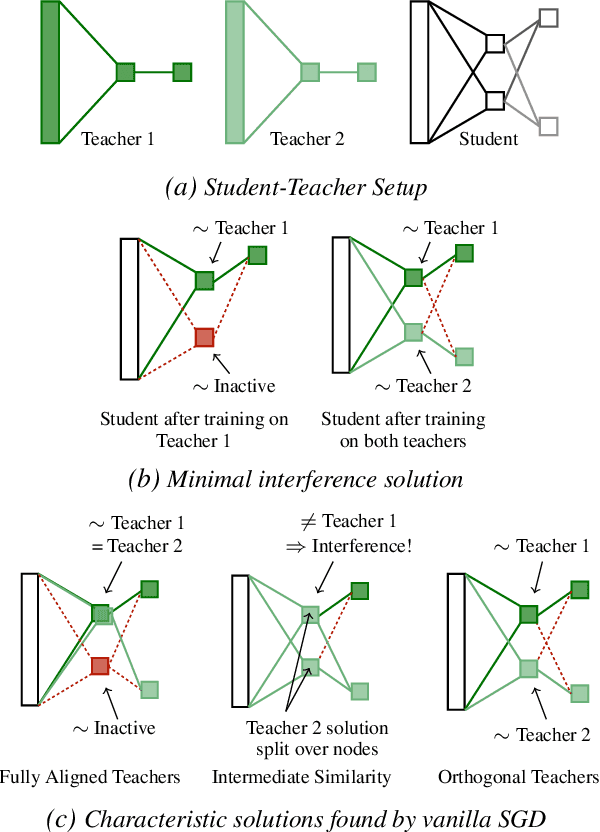
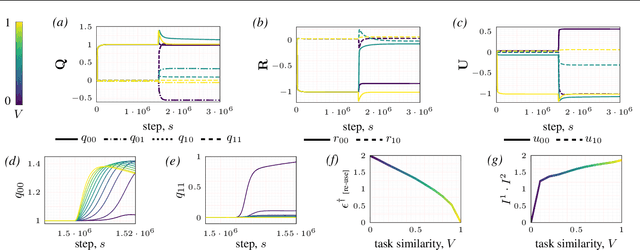

Abstract:Continual learning - learning new tasks in sequence while maintaining performance on old tasks - remains particularly challenging for artificial neural networks. Surprisingly, the amount of forgetting does not increase with the dissimilarity between the learned tasks, but appears to be worst in an intermediate similarity regime. In this paper we theoretically analyse both a synthetic teacher-student framework and a real data setup to provide an explanation of this phenomenon that we name Maslow's hammer hypothesis. Our analysis reveals the presence of a trade-off between node activation and node re-use that results in worst forgetting in the intermediate regime. Using this understanding we reinterpret popular algorithmic interventions for catastrophic interference in terms of this trade-off, and identify the regimes in which they are most effective.
 Add to Chrome
Add to Chrome Add to Firefox
Add to Firefox Add to Edge
Add to Edge